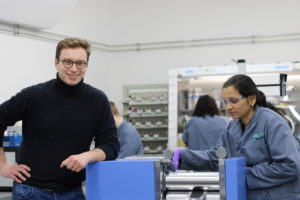WEDNESDAY, 26 FEBRUARY 2020
Echion Technologies, a spinout technology company from the University of Cambridge Engineering Department, have revealed a breakthrough in the design of lithium rechargeable batteries. Thanks to the unique material of its anode - Mixed Niobium Oxide (MNO) - their new battery can be fully recharged in as little as 6 minutes, a 200% improvement over current commercial competitors.Dr Jean de La Verpilliere founded Echion with his PhD supervisors in 2017, during the final year of his PhD at the University of Cambridge’s EPSRC Doctoral Training Centre for Nanoscience and Nanotechnology. The company focuses on innovating high-performance materials for lithium batteries and was inspired by Dr de La Verpilliere’s discovery of the new material, MNO, which could be used in such batteries. This discovery was no simple task –it required the trialling of hundreds of compounds, followed by thousands of iterative tests until the final commercial-grade product could be achieved. “We are excited about the announcement because it is the result of both great science and great engineering that took a lot of work”, says Dr de La Verpilliere.
As the name suggests, rechargeable batteries can be recharged and discharged in order to power devices multiple times. In contrast, disposable batteries, such as alkaline batteries, must be discarded after a single use, resulting in the production of hazardous waste from the toxic heavy metals and strong acids they contain. The basic components of a rechargeable battery include a cathode, an anode, and an electrolyte, which may be liquid or solid. “Powders form the central component of rechargeable batteries”, Dr de La Verpilliere stresses. Different types of powders, such as graphite, are often added to the battery to improve its properties.
 Jean de La Verpilliere, CEO, and members of the Echion team at work in their Sawston battery R&D facility where the Echion fast-charging MNO niobium material was developed.
Jean de La Verpilliere, CEO, and members of the Echion team at work in their Sawston battery R&D facility where the Echion fast-charging MNO niobium material was developed.Unlike conventional Li-ion graphite batteries, the MNO anode of Echion Technologies’ new battery prevents explosions from being triggered even when fast-charging, due to their safer electrochemical potential. At the same time, this new material offers all the advantages of LTO batteries – speed of charging, long lifespan and improved safety – without the trade-offs of high costs and low energy density. “This is a major milestone in our technology roadmap. With this commercial-grade prototype we demonstrate a safe 6-min charge power cell with a 640 mAh/cm3 volumetric capacity anode, which is a 200% improvement over the best LTO anodes” Dr de La Verpilliere says. He believes that the MNO niobium material will allow the development of “advanced batteries [for] large markets where the safety, charge rate capability, or energy density limitations of commercial anode materials had so far prevented the adoption of fast-charging technologies”
One area of interest concerning the development of improved batteries is electric car technology. Currently, several bottlenecks exist in the widespread use of electric cars, with charge time, range anxiety and cost being cited as the biggest issues for consumers. Dr de La Verpilliere believes that speed of charge is central to all three of these issues, explaining that “…if a battery technology, such as our MNO niobium technology, enables effortless fast charge in 6 min, then it is not so much of a problem for the user to recharge their cars often. That means that range anxiety becomes meaningless, and that cars with smaller battery packs can be designed, hence saving hugely on costs.” Furthermore, the MNO battery is compatible with standard charging infrastructure. With the number of electric charging points having overtaken the number of refuelling stations in the UK (Nissan, 2019), it is likely that technology improvements and subsequent demand for electric vehicles will overcome any shortfalls in charging station availability. Given the pressing need for climate friendly travel solutions, it is likely that faster, safer, more reliable batteries will be central in the transition to a greener travel infrastructure.
Looking to the future, the company currently plans to reduce the charging time of their MNO battery by a further 4 minutes. Currently, Echion Technologies is working with several partners, including advanced materials manufacturer William Blythe Ltd., in the hopes of launching their new MNO niobium batteries into the market by 2022, potentially bringing with it a new era for rechargeable battery technology.
Read the press release here.
Leia Judge is a 2nd year PhD student in the Department of Physiology, Development and Neuroscience and the President of BlueSci magazine.
